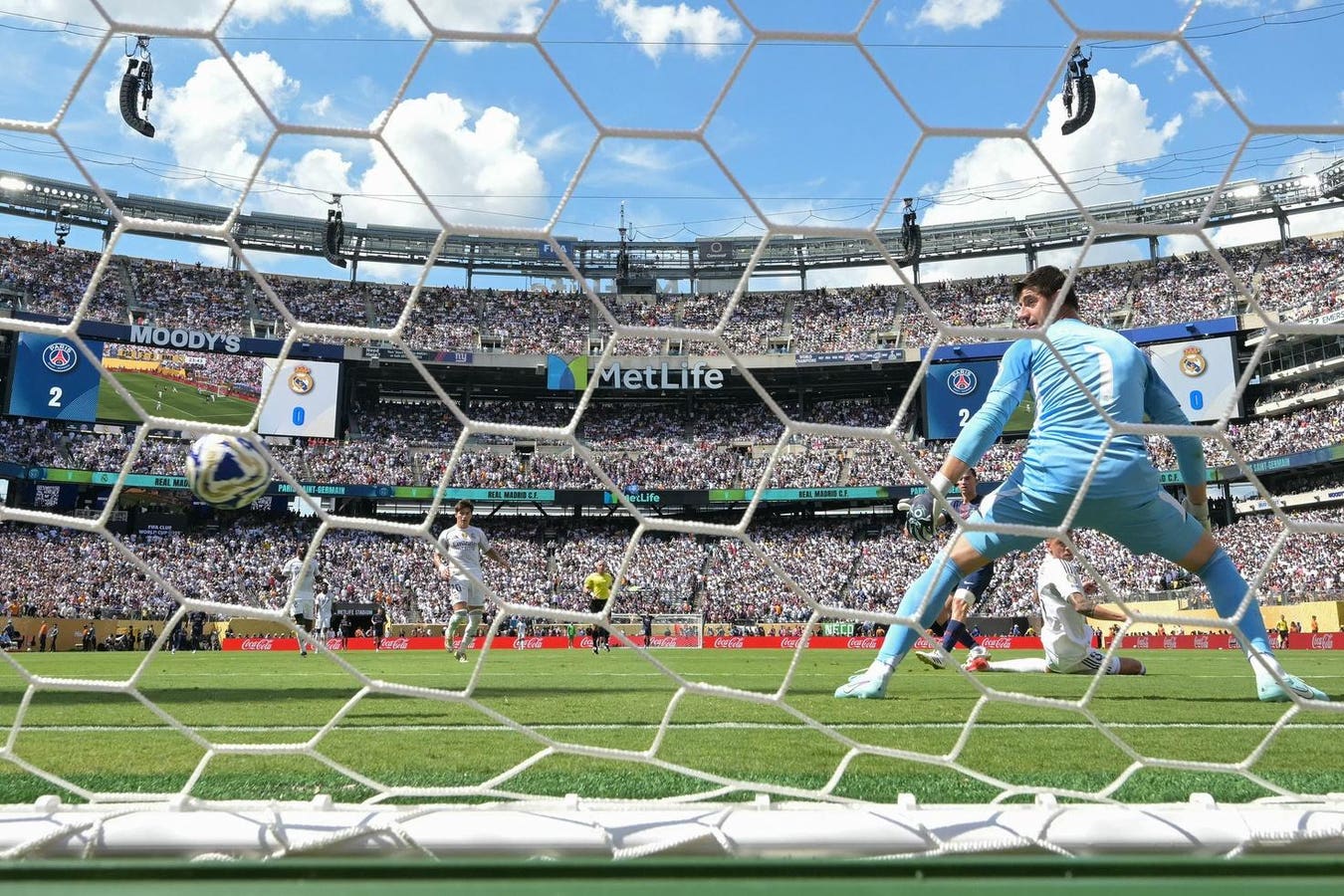Paris Saint-Germain’s Spanish midfielder #08 Fabian Ruiz scores his team’s third goal during the … More
FIFA Club World Cup 2025 has made headlines for more than just soccer. Elite performances have been on display, but much of the spotlight has been on delays caused by heatwaves and lightning storms, welfare concerns from coaches and players, attendance figures and questions around commercial integrity.
From an extreme weather, climate and sustainability standpoint, the tournament has delivered a critical wake up call ahead of the 2026 Men’s World Cup, taking place in the U.S as well as Mexico and Canada in the same summer timeframe. Experts have urged FIFA to make proactive decisions to protect players, fans, and the integrity of the competition as climate risks intensify. Ideas include adjusting match times and even altering game formats, if there is a repeat of the record-breaking heat and weather disruptions experienced this year.
“From a thermal-physiological perspective, for both health and performance reasons, I’d be looking to start games as early as possible,” professor of human and applied physiology at Portsmouth University, Professor Mike Tipton shared recently. “It’s not beyond the realms that matches have to go to quarters rather than halves,” he went on.
PASADENA, CALIFORNIA – JUNE 15: Paris Saint-Germain players head to the bench during a cooling break … More
World players’ union Fifpro has shared similar thoughts, advocating for more frequent cooling breaks and a longer half-time breaks. “A half-time of 15 minutes might not be enough to decrease the core temperature. So a lot of research is being done into alternative mitigation strategies and it could be that a half-time of 20 minutes is significant,” shared Dr Vincent Gouttebarg Fifpro’s medical director. 31 of the first 54 matches at Club World Cup had cooling breaks.
Although match times will not be announced until later this year, the dates and locations of games for 2026 men’s World Cup games are already set. Attention is turning to how these venues are stepping up, not only to adapt and be match-ready in an era of escalating climate risks, but to mitigate their longer-term environmental impacts. The majority of venues hosting Club World Cup games this year, as well as Men’s World Cup matches next year, have some environmental sustainability efforts ongoing, but a number stand out due to their longer-term, systemic and visible efforts.
Lincoln Financial Field, Philadelphia
Lincoln Financial Field is home to Philadelphia Eagles, winners of the 2025 Super Bowl, has hosted six FIFA Club World Cup fixtures this year and will host six games for Men’s World Cup 2026. Tea
“Sustainability is a core value of our operation at both the Philadelphia Eagles and Lincoln Financial Field. It’s a privilege to showcase our stadium’s sustainability efforts on one of the largest stages in sports,” vice president of fan experience and sustainability, Norman Vossschulte shared with me recently.
Advanced waste systems include a closed-loop program converting bottle caps into stadium materials, reverse vending machines, and widespread composting, achieving waste diversion rates of up to 99%. The installation of water refill stations and efficient fixtures has prevented over a million plastic bottles from entering landfill.
Lumen Field, Seattle
Lumen Field also hosted six Club World Cup matches and will welcome six more World Cup fixtures in 2026, including a U.S. Men’s National Team game. “Environmental sustainability is integrated throughout our departments and programs,” sustainability manager for Lumen Field and Seattle Seahawks, Christy Briggs told me. As an organization they say they are willing to take risks that are informed by the best available science and supported by those who have come before.
In the past 12 months, 98% of the building’s lighting has been converted to LED, which can be up to 80% more energy efficient than traditional bulbs. During Club World Cup, Lumen Field separated aluminium and plastic to further ensure where their recycling goes. “This is not a part of our normal process and our team was able to do it while still maintaining our other sorting. We are hoping not only to move forward with this at the World Cup but integrating it into our regular processes,” Briggs shared.
“It is also important that we impact our fans and communities. If our fans learn and adopt some element of environmental sustainability that they learn from us, we exponentially make a bigger impact than our programs alone,” she went on. Guidelines on how to be a more sustainable fan include encouraging fans to carpool, donate unused clothes, choose locally sourced plant-based foods and learn how to recycle and compost.
Mercedes‑Benz Stadium, Atlanta
Mercedes‑Benz Stadium is the only stadium that hosted 2025 Club World Cup games with a retractable roof. However for next summer’s World Cup, players and spectators will benefit from other stadiums having this too, in Dallas, Houston, Los Angeles in the U.S., and Vancouver and Toronto in Canada.
MBS hosted six matches of the Club World Cup, including marquee gatherings like PSG vs. Bayern Munich, and is slated as a key venue for the 2026 FIFA Men’s World Cup, hosting eight matches including the semi-final.
ATLANTA, GEORGIA – JUNE 16: General view inside the stadium during the FIFA Club World Cup 2025 … More
Opened in 2017, it was the first professional sports venue to earn LEED Platinum certification, a standard awarded for sustainable design and construction. It also became the first to earn TRUE Platinum certification for zero-waste practices, diverting over 90% of event and administrative waste. Sustainability features include over 4,000 rooftop solar panels that generate enough energy to fully power nine Falcons or 13 Atlanta United games.
Climate change is intensifying the global water cycle, leading to more frequent and severe flooding and drought. MBS is built to be prepared for both. Its stormwater management includes an underground 1.1 million-gallon vault that captures and releases stormwater to help prevent flooding in neighboring communities. A 680,000-gallon cistern harvests rainwater that is used for irrigating outdoor areas, this and various water-conserving efforts have reduced water use by nearly 50%.
Adam Fullerton, vice president of operations at Mercedes-Benz Stadium told me recently that during major global events like the Club World Cup and the upcoming FIFA World Cup in 2026, they are “doubling down” on these efforts. “Hosting guests from around the world is an incredible honor, and we want every fan experience to reflect our dedication to reducing landfill waste, curbing our carbon footprint, and driving systemic change,” he shared. “Sustainability isn’t just a priority during everyday operations, it’s embedded in how we prepare for and deliver the world’s biggest events.”
MetLife Stadium, New Jersey
Hosting the final for 2025 Club World Cup and 2026 Men’s World Cup Final, MetLife Stadium also hosted seven additional matches this year and five next year. The stadium has no roof, so thermal exposure to spectators and players is intensified, especially when contending with the temperature highs of 102 degrees experienced this June.
METLIFE STADIUM, EAST RUTHERFORD, NEW JERSEY, UNITED STATES – 2025/07/08: A giant screen displays … More
A UNFCCC Sports for Climate Action Framework signatory, the stadium is working towards net-zero by 2040. Its environmental efforts include onsite solar energy generation, water-saving fixtures, and recycling programs. It has implemented hybrid and electric vehicle infrastructure, and diverts and donates food and material waste.
The stadium encourages fans to get involved in efforts too, through carpooling and public transport, green tailgating that prioritises reuse and recycling, and choosing locally sourced foods.
As the final whistle blows on the FIFA Club World Cup 2025 this weekend, operational and environmental pressures in a major sports tournament has once again been exposed. While stadiums show sustainability leadership, heat delays, storm disruptions, and concerns over player welfare and fan experience highlight the need for a more climate-ready tournament model. With the FIFA Men’s World Cup 2026 on the horizon, many of its matches set in the same venues, learnings can offer a crucial opportunity to rethink scheduling, strengthen sustainability commitments, and ensure that soccer’s global showpiece is genuinely evolving towards climate resilience in line with FIFA’s stated commitments.









